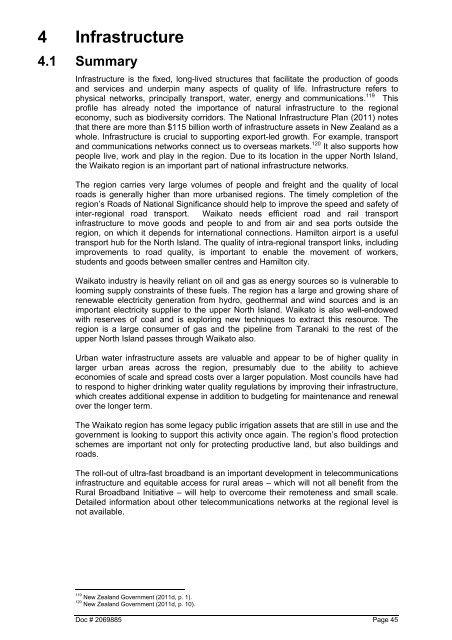Waikato regional economic profile - Waikato Regional Council
Waikato regional economic profile - Waikato Regional Council
Waikato regional economic profile - Waikato Regional Council
- No tags were found...
You also want an ePaper? Increase the reach of your titles
YUMPU automatically turns print PDFs into web optimized ePapers that Google loves.
4 Infrastructure4.1 SummaryInfrastructure is the fixed, long-lived structures that facilitate the production of goodsand services and underpin many aspects of quality of life. Infrastructure refers tophysical networks, principally transport, water, energy and communications. 119 This<strong>profile</strong> has already noted the importance of natural infrastructure to the <strong>regional</strong>economy, such as biodiversity corridors. The National Infrastructure Plan (2011) notesthat there are more than $115 billion worth of infrastructure assets in New Zealand as awhole. Infrastructure is crucial to supporting export-led growth. For example, transportand communications networks connect us to overseas markets. 120 It also supports howpeople live, work and play in the region. Due to its location in the upper North Island,the <strong>Waikato</strong> region is an important part of national infrastructure networks.The region carries very large volumes of people and freight and the quality of localroads is generally higher than more urbanised regions. The timely completion of theregion’s Roads of National Significance should help to improve the speed and safety ofinter-<strong>regional</strong> road transport. <strong>Waikato</strong> needs efficient road and rail transportinfrastructure to move goods and people to and from air and sea ports outside theregion, on which it depends for international connections. Hamilton airport is a usefultransport hub for the North Island. The quality of intra-<strong>regional</strong> transport links, includingimprovements to road quality, is important to enable the movement of workers,students and goods between smaller centres and Hamilton city.<strong>Waikato</strong> industry is heavily reliant on oil and gas as energy sources so is vulnerable tolooming supply constraints of these fuels. The region has a large and growing share ofrenewable electricity generation from hydro, geothermal and wind sources and is animportant electricity supplier to the upper North Island. <strong>Waikato</strong> is also well-endowedwith reserves of coal and is exploring new techniques to extract this resource. Theregion is a large consumer of gas and the pipeline from Taranaki to the rest of theupper North Island passes through <strong>Waikato</strong> also.Urban water infrastructure assets are valuable and appear to be of higher quality inlarger urban areas across the region, presumably due to the ability to achieveeconomies of scale and spread costs over a larger population. Most councils have hadto respond to higher drinking water quality regulations by improving their infrastructure,which creates additional expense in addition to budgeting for maintenance and renewalover the longer term.The <strong>Waikato</strong> region has some legacy public irrigation assets that are still in use and thegovernment is looking to support this activity once again. The region’s flood protectionschemes are important not only for protecting productive land, but also buildings androads.The roll-out of ultra-fast broadband is an important development in telecommunicationsinfrastructure and equitable access for rural areas – which will not all benefit from theRural Broadband Initiative – will help to overcome their remoteness and small scale.Detailed information about other telecommunications networks at the <strong>regional</strong> level isnot available.119New Zealand Government (2011d, p. 1).120New Zealand Government (2011d, p. 10).Doc # 2069885 Page 45
















